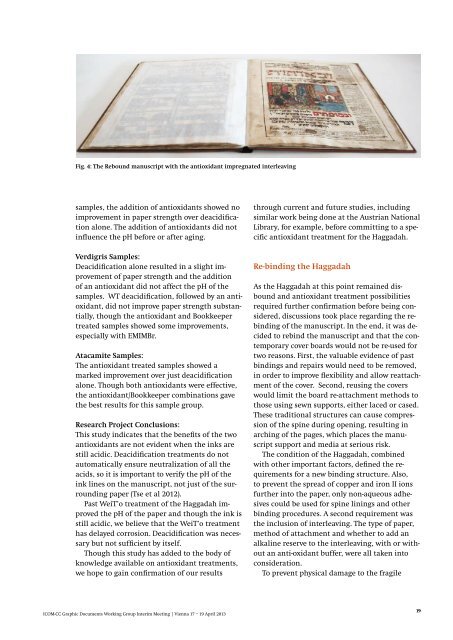Paper Conservation: Decisions & Compromises
Paper Conservation: Decisions & Compromises
Paper Conservation: Decisions & Compromises
Create successful ePaper yourself
Turn your PDF publications into a flip-book with our unique Google optimized e-Paper software.
Fig. 4: The Rebound manuscript with the antioxidant impregnated interleaving<br />
samples, the addition of antioxidants showed no<br />
improvement in paper strength over deacidification<br />
alone. The addition of antioxidants did not<br />
influence the pH before or after aging.<br />
Verdigris Samples:<br />
Deacidification alone resulted in a slight improvement<br />
of paper strength and the addition<br />
of an antioxidant did not affect the pH of the<br />
samples. WT deacidification, followed by an antioxidant,<br />
did not improve paper strength substantially,<br />
though the antioxidant and Bookkeeper<br />
treated samples showed some improvements,<br />
especially with EMIMBr.<br />
Atacamite Samples:<br />
The antioxidant treated samples showed a<br />
marked improvement over just deacidification<br />
alone. Though both antioxidants were effective,<br />
the antioxidant/Bookkeeper combinations gave<br />
the best results for this sample group.<br />
Research Project Conclusions:<br />
This study indicates that the benefits of the two<br />
antioxidants are not evident when the inks are<br />
still acidic. Deacidification treatments do not<br />
automatically ensure neutralization of all the<br />
acids, so it is important to verify the pH of the<br />
ink lines on the manuscript, not just of the surrounding<br />
paper (Tse et al 2012).<br />
Past WeiT’o treatment of the Haggadah improved<br />
the pH of the paper and though the ink is<br />
still acidic, we believe that the WeiT’o treatment<br />
has delayed corrosion. Deacidification was necessary<br />
but not sufficient by itself.<br />
Though this study has added to the body of<br />
knowledge available on antioxidant treatments,<br />
we hope to gain confirmation of our results<br />
through current and future studies, including<br />
similar work being done at the Austrian National<br />
Library, for example, before committing to a specific<br />
antioxidant treatment for the Haggadah.<br />
Re-binding the Haggadah<br />
As the Haggadah at this point remained disbound<br />
and antioxidant treatment possibilities<br />
required further confirmation before being considered,<br />
discussions took place regarding the rebinding<br />
of the manuscript. In the end, it was decided<br />
to rebind the manuscript and that the contemporary<br />
cover boards would not be re-used for<br />
two reasons. First, the valuable evidence of past<br />
bindings and repairs would need to be removed,<br />
in order to improve flexibility and allow reattachment<br />
of the cover. Second, reusing the covers<br />
would limit the board re-attachment methods to<br />
those using sewn supports, either laced or cased.<br />
These traditional structures can cause compression<br />
of the spine during opening, resulting in<br />
arching of the pages, which places the manuscript<br />
support and media at serious risk.<br />
The condition of the Haggadah, combined<br />
with other important factors, defined the requirements<br />
for a new binding structure. Also,<br />
to prevent the spread of copper and iron II ions<br />
further into the paper, only non-aqueous adhesives<br />
could be used for spine linings and other<br />
binding procedures. A second requirement was<br />
the inclusion of interleaving. The type of paper,<br />
method of attachment and whether to add an<br />
alkaline reserve to the interleaving, with or without<br />
an anti-oxidant buffer, were all taken into<br />
consideration.<br />
To prevent physical damage to the fragile<br />
ICOM-CC Graphic Documents Working Group Interim Meeting | Vienna 17 – 19 April 2013<br />
19
















